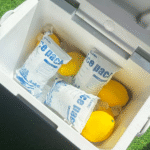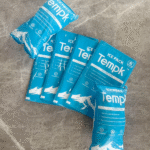paquete de 100 Paquetes de hielo seco: How to Ship Smarter in 2025
If you’re scaling frozen or ultra-cold shipping, a paquete de 100 paquetes de hielo seco helps you standardize pack-outs, control costs, and keep lanes stable across seasons. Actualizado Octubre 2025, this guide shows you how to size your program, stay compliant, and cut loss rates without sacrificing speed.
-
Sizing rules that turn transit hours into the dry-ice mass you actually need
-
Safety and labeling steps that pass 2025 airline acceptance checks
-
When VIP insulation and PCMs beat dry ice on total cost for your lanes
-
Ways to roll out training and QA that scale with order volume
-
Inventory rhythms and reorder points for a paquete de 100 paquetes de hielo seco compra
Why buy a pack of 100 paquetes de hielo seco?
-
Consistencia: Standardizes dosing across shifts and sites.
-
Velocidad: Pre-bagged portions cut pack-out time per order.
-
Calidad: Uniform refrigerant mass reduces variation.
-
Escalabilidad: Easier to plan weekly rhythms.
When does a pack of 100 dry ice packs make sense?
Choose a pack of 100 dry ice packs when you ship frozen goods daily and need repeatable, fast pack-outs at sub-zero set points.
You gain predictability because every portion is identical, helping new staff follow SOPs and reducing re-packs. High-quality packs hold sub-zero temperatures for about 24–72 hours depending on insulation quality. Reusable packs survive up to 30 cycles with careful handling, saving budget while raising service levels.
Bloques, bandear, or pre-bagged portions?
| Formato | Mejor para | Workflow fit | Lo que significa para ti |
|---|---|---|---|
| Bloques/Losas | Long duration lanes | Menos piezas | Sublimación más lenta |
| Pellets/Pepitas | Desplegable rápido | Flexible dosing | Sublimación más rápida |
| Pre-bagged portions | Repeatable pack-outs | Time-saving | Consistent QA |
Material options
| Tipo de paquete | Duración del enfriamiento | Peso | Mejor caso de uso |
|---|---|---|---|
| HDPE shell pack | 48–72 h | Luz | Long-distance pharma |
| Gel-based PCM pack | 24–48 H | Moderado | Kits de comida |
| Bio-based reusable pack | 36–60 horas | Medio | Sustainable operations |
Consejos prácticos
-
Multi-day transit: Blend ~80% blocks + ~20% pellets.
-
Paquetes más limpios: Bag pellets to reduce CO₂ “snow.”
-
Reutilizar: Track cycles and retire damaged packs.
Estudio de caso: A dessert brand cut returns by half after switching to pre-bagged portions. Pack time fell by 30 seconds per order.
¿Cuánto hielo seco debes usar??
Planifique de 5 a 10 libras de hielo seco por 24 h of transit inside an insulated shipper; add one day for delays.
Para 40 frozen orders/day and two-day lanes, necesitas aproximadamente 560 lb daily. un paquete de 100 × 5-lb portions covers 500 lb, so order two weekly to maintain inventory.
estimador rápido
Safe and compliant packaging
Vent every container, label UN 1845, and train staff on PPE and CO₂ safety.
Dry ice releases gas that displaces oxygen—vent lids, post signage, and monitor storage rooms.
| Enfoque de seguridad | Que hacer | Por que importa |
|---|---|---|
| Ventilación | Use vented lids | Prevents oxygen loss |
| Etiquetado | marca un 1845 + peso | Meets IATA rules |
| Escucha | Utilice sensores de CO₂ | Ensures safe workspace |
When to switch to PCMs or gels
Use PCMs for tight 2–8 °C control or reusable loops, and reserve dry ice for < −20 °C or fast pull-down.
PCMs simplify paperwork; gel packs suit short local routes. Muchos 2025 shippers blend −21 °C PCM with dry ice to balance cost and safety.
2025 trends in ultra-cold shipping
Reusable packaging and smarter insulation dominate 2025. Programs adopting VIP shippers cut refrigerant mass by about one-third, while IoT monitoring reduces excursions.
Últimas novedades
-
personaje + híbridos PCM: Small dry-ice loads ease DG paperwork.
-
Tamaño correcto: Validated kits reduce ice use 15–30%.
-
Monitoreo de CO₂: Low-cost sensors now standard.
Preguntas frecuentes
¿Puedo volar con hielo seco??
Sí, utilice envases ventilados, Marcar un 1845 y peso neto, and follow IATA rules.
How should I store it?
Keep in a cool, ventilated room with loose lids. Never in a sealed freezer.
How long will it last?
Expect 5–10 lb to sublimate every 24 h; premium insulation lowers the rate.
Will it damage packaging?
Extreme cold can make thin plastics brittle—add a liner and avoid direct contact.
Is “dry ice pack” the same as gel pack?
No. El hielo seco es CO₂ sólido. (−78,5°C); gels use water-based PCMs for higher temps.
Ideas de enlaces internos (for your own site)
-
Validated −80 °C shippers for biologics
-
PCM 2–8 °C pack-out guide
-
Dry-ice safety checklist
-
Frozen pack-out SOP template
Summary and advice
Elija un paquete de 100 paquetes de hielo seco to standardize frozen shipping, follow the 5–10 lb/24 h rule, and design vented, labeled packaging. Use VIPs or −21 °C PCMs when they reduce cost, and train teams for safe, repeatable pack-outs.
Siguiente paso: map your top three lanes, run an A/B test, and finalize your SOP this week.
Acerca de Tempk
We engineer and validate cold-chain packaging for food, cuidado de la salud, y materiales avanzados. Our tested kits around a paquete de 100 paquetes de hielo seco typically reduce dry-ice use by 15–30% while maintaining lane time.
Acción: Get a quick consultation to validate your configuration.
























